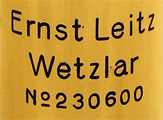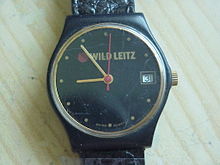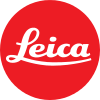Leitz (optics)
The Leitz company was founded in 1869 by Ernst Leitz as the successor to the Optical Institute founded by Carl Kellner (company founder) in Wetzlar in 1849 . It quickly became a leading supplier of microscopes and , from 1924, cameras as well. After mergers in 1986 and 1990, a large “Leica Group” was formed, which was dissolved in 1996/97. The subsidiaries Leica Microsystems , Leica Camera and Leica Geosystems were created .
1849 to 1920

Carl Kellner , mechanic and mathematical self-taught, had published the treatise Das orthoskopische Ocular, a newly invented achromatic lens combination in 1849 , in which he described a lens combination he had developed. This eyepiece was able to produce an image with correct perspective without the distortions common in microscopes of the time. After Kellner's untimely death on May 13, 1855, his widow continued the company.
The precision mechanic Ernst Leitz I (1843–1920) from Baden came to Wetzlar in 1864 and joined the workshop of the “Optical Institute”. He trained as an instrument maker for physical and chemical devices as well as several years of practical experience in the Swiss watch industry. Initially, Leitz was a partner in the company (1865), but in 1869 he took over the company as the sole owner and continued to run it under his own name. Leitz introduced series production in the Wetzlar workshops: sales increased rapidly after 1871. He always sought contact with users and designed the microscopes with the specific requirements of his customers in mind.
Microscopes were manufactured for biomedical applications and for industrial investigations, for example for mineralogy. The microscopes that had been common up to that point were improved in many ways (especially mounting, lighting, optics, orthoscopic eyepieces). In 1880 the company had an annual production of 500 devices. In 1887 the 10,000. Microscope sent, four years later the 20,000. and in 1899 the 50,000. completed. In 1907, the bacteriologist Robert Koch received the company's hundred thousandth microscope. Paul Ehrlich , founder of chemotherapy, received the 150,000. Microscope, Nobel laureate Gerhard Domagk , the discoverer of the sulfonamides , the 400,000th Leica instrument.
At the end of the 19th century the company already had a worldwide reputation. In addition to microscopes, the product range also included various other optical instruments. At the beginning of the new century, Leitz introduced the eight-hour day and founded a health insurance association for its employees. In 1913 the company presented the first fully functional binocular microscope . The First World War did not leave Leitz unaffected, the economic situation after the lost war was very bad. This also affected the Wetzlar company W. & H. Seibert , which was incorporated into the Ernst Leitz company in 1917.
Ernst Leitz died in July 1920, the management of the company was now in the hands of his son, Ernst Leitz II .
1920 to 1970
Epidon: Cooke triplet f3.6 / 420 as an episcope projection lens
Around 1920 the Leitz works employed around 1400 and in 1956 around 6000 people. Ernst Leitz II decided in 1924 to mass-produce the apparatus of his colleague Oskar Barnack , despite the difficult market situation . Barnack had used today in the course of development work for the new film from the 35 mm footage mm film developed. Since the aspect ratio of 2: 3 seemed ideally harmonious to him, the image height of 24 mm resulted in a width of 36 mm. Around this film format he constructed an exposure device with a fixed shutter sequence and focal length, a 35mm camera for taking snapshots in between. The production of the original Leica (see Leica Camera ), as presented at the spring fair in Leipzig in 1925, was based on this concept . The success was enormous and unpredictable.
The first polarizing microscope followed in 1925 . The first comparative macroscope for criminal purposes was created as early as 1931. In 1932 the company brought incident light fluorescence onto the market, and three years later the photometer developed by Max Berek .
In the late 1930s, Ernst Leitz II supported a large number of Jewish employees in his company in their timely escape from National Socialist Germany. Ernst Leitz GmbH employed a total of 195 foreigners in September 1942 - in January 1945 there were 989 forced laborers : 643 "Eastern workers", mainly from the Ukraine, and 316 "Western workers" from France and the Benelux countries.
In addition to cameras and microscopes, the company developed and marketed other optical products that shaped the mid-20th century. These include, for example, slide projectors from the Prado line or the Leitz episcopes that are often used in schools .
In the meantime, Ernst Leitz II's three sons ( Ludwig , Ernst and Günther ) joined the company one after the other . The company was spared destruction during the Second World War and was able to resume production immediately after the end of the war. In 1948 a separate development laboratory for optical glass was added. From 1953 the microscope optics were calculated with the help of IT . The Leitz sons jointly took over management of Ernst Leitz GmbH after the death of their father in 1956.
From 1970
At the beginning of the 1970s, the name was changed to Ernst Leitz Wetzlar GmbH , as it was feared that the well-known name of Wetzlar would be lost when Gießen and Wetzlar were merged into the city of Lahn in 1977 . However, the town of Lahn was dissolved again in 1979, and Gießen and Wetzlar became independent again.
- In 1972 a cooperation agreement was signed with the Swiss optics company Wild Heerbrugg for the development and construction of microscopes. Wild took over 25% of Leitz through a capital increase.
- In 1974, Wild took over a further 26% of the shares from the Leitz family.
- In 1987 the WILD LEITZ Group was founded with headquarters in Zurich,
- In 1989 the company Wild Heerbrugg AG was renamed Wild Leitz AG.
- 1990 WILD LEITZ and Cambridge Instruments merged to form the LEICA Group.
- 1990 The Industrial Metrology Division (IMT) was spun off as Leitz Messtechnik GmbH. Brown & Sharpe were the new owners.
- 2003 From then on the company belonged to Hexagon and traded under the name Leitz Meßtechnik GmbH.
- 2005 Effective January 1, 2005, Leitz Meßtechnik GmbH is renamed Hexagon Metrology GmbH . The product name Leitz was retained.
A cooperation has also been entered into in the area of 35 mm slide projectors , here with Kindermann . In 1982 Kindermann and Leitz brought the Leitz Kindermann magazine for unglazed slides onto the market. Some of the smaller slide projectors from Leitz were equipped with Kindermann technology (Pradovit R 150, Pradovit RA 150) or manufactured entirely by Kindermann from 1988 to 1990 (Pradovit 153/253). Until 1988, large parts of the neighboring company Will belonged to Wild Leitz. Will was resold to Helmut Hund GmbH.
In 1990 Wild Leitz Holding AG merged with the Cambridge Instruments Group. This group included Cambridge Instruments (founded in 1881 by Horace Darwin ) itself, the Heidelberg microtome manufacturer Jung (founded 1872), the Vienna optics manufacturer Reichert (founded 1876) as well as the microscopy divisions of the North American optical companies Bausch & Lomb (founded 1853) and American Optical (founded in 1847). The new group was called Leica Plc and thus included the entire North American microscope industry.
The Leica Group was dissolved in 1996/97: In 1996, Leica Camera , based in Solms, west of Wetzlar, went public on the Frankfurt Stock Exchange . The remaining company was split in 1997 into Leica Geosystems , headquartered in Balgach , Switzerland, and Leica Microsystems . Leica Microsystems received the rights to the Leica brand, the other two companies received license rights to the brand.
Web links
- Literature on Leitz in the Hessian Bibliography
- One of the first microscopes made by Ernst Leitz in 1869
- Small microscope by Ernst Leitz from 1878 which shows the start of series production
- The “Leitz Ortholux” microscope - portrait on a private collector's website
Individual evidence
- ↑ a b c d e f Leica Microsystems ( Memento of the original from August 9, 2009 in the Internet Archive ) Info: The archive link was inserted automatically and has not yet been checked. Please check the original and archive link according to the instructions and then remove this notice. , accessed on August 23, 2015.
- ↑ See footnote 20 in Karsten Porezag: Ernst Leitz from Wetzlar and the Jews - Myth and Facts on the Emigration of German Jews 1933-1941 , Berlin 2009. ISBN 978-3-940938-23-7
- ↑ a b Rudolf Simmen: From Wild to Leica - 70 years of company history. 1991. Available on the web as a PDF file from the Leica Geosystems website ( direct link ; PDF; 17.4 MB)
- ↑ a b Leica Heerbrugg through the ages - company portrait. 1996. Leica AG, Heerbrugg. Available on the web as a PDF file on the Leica Geosystems website ( direct link ; PDF; 916 kB)
- ↑ History of Leitz-Metrology ( Memento of the original from January 15, 2012 in the Internet Archive ) Info: The archive link was automatically inserted and not yet checked. Please check the original and archive link according to the instructions and then remove this notice. , www.leitz-metrology.com, accessed April 28, 2012.
- ↑ a b History of projector production at Leitz / Leica , pradomuseum.eu, accessed on August 23, 2015.
- ↑ Christoph Jehle: Pradovit- Diaprojektoren, photoscala.de, accessed on August 23, 2015.
- ^ A Historical Perspective: The pioneers and visionaries of the survey world - Our development , www.leica-gosysteme.com, accessed on August 23, 2015.
- ↑ Press release from Leica Microsystems dated February 24, 2005 ( page no longer available , search in web archives ) Info: The link was automatically marked as defective. Please check the link according to the instructions and then remove this notice. , no longer available on the web April 28, 2012.










